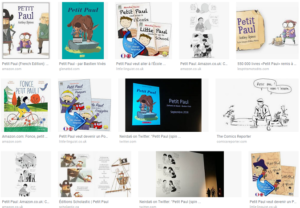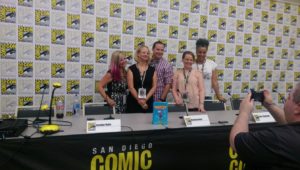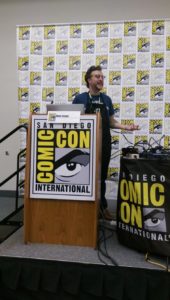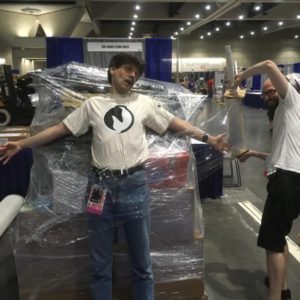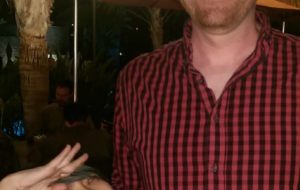There should be a picture here, but it was all blurry so, oh well.
[Editor’s note: As in the past, these panel recaps are based on notes typed during the session; all discussion is the nearest possible paraphrase, except for direct quotes which will be italicized.]
Here’s the thing about panels — lineups change. Things get in the way, or you realize that you agreed to do about three more sessions than a reasonable person could wrangle this week, and maybe you need to step back from two of them. With a good moderator, though, you’d never guess and the panel on Superstars In Children’s Graphic Novels picked up a substitute moderator who is top notch. Or maybe they just didn’t want the world to know that Raina Telgemeier would be slinging the questions, so that kids would come to see the other folks on the panel? Either way, it was a great piece of expectation-management, and a great way to ensure a smooth experience for all¹.
And a good thing, too, because kids? Kids are utterly fearless about what they love. There were two in line who their dad said were normally shy around adults, but they peppered me with questions, wanting to know what I was, why I was coming the panel for, who my favorites were, and do I know ______ ? I’m pretty sure they hit everybody on the dais for autographs and photos afterwards. Those folks (all of whom are published by Scholastic) were, in addition to Raina:
Gale Galligan (who is continuing the Baby Sitters Club graphic novels), Ian Boothby (Eisner winner and contributor to Bongo comics), Molly Ostertag (creator of my favorite book of 2017), Aron Steinke (Eisner winner and 2nd grade teacher), and Jarrett Krosoczka (author and/or illustrator of 25+ books including the Jedi Academy and Lunch Lady series). It was some star power, is what I’m saying.
Raina opened with a two-part question to the entire panel, then tended to follow up ideas with particular creators, and finished her part with a Lightning Round before moving onto Q&A. That two parter was to ask the panelists about books from their own childhoods that had an emotional impact, or made them laugh. There was a general agreement on newspaper comic strips among the panelists (IB: Peanuts, GG: Calvin & Hobbes, The Far Side; JK: I’d read the comics page and pretend to understand why some were funny. Yeah, lasagna’s awesome and I hate Mondays too.; MO: I didn’t understand all of The Far Side, but I loved the absurd way that Larson would draw a cow with a face and glasses) regarding laughter, but the emotional impact books ranged all over: Ostertag loved the His Dark Materials series and remembered listening to audiobooks and sobbing w/emotion, happy to be sad. Boothby also found emotion in Peanuts, where all the kids seems to be having a rough time, it was funny but also the kid was bummed out, talked about all his problems, quoted a bible verse, and spoiled Citizen Kane. Linus would bust out a bible verse, but he worshiped the Great Pumpkin.
Krosoczka cited The Mouse And The Motorcycle in particular, and all of Beverly Cleary’s books in general (he revisited them with his daughter last year, and was relieved they still hold up). I had a hamster, always thought he could learn to ride a motorcycle, but he never did. Galligan was a huge fan of the Animorphs series, which started out about teens that can turn into animals and ends up being a story about the horrors of war and I would just sob. Steinke loved Alvin Schwartz’s Scary Stories series, particularly the illustrations — so creepy, they’re challenged and banned in some places. Ostertag chimed in that she loved reading those stories, but was afraid to touch the illustrations afraid they’d come off in her hand.
The second general question was why each of the authors writes for children, and what makes the audience distinctive. Boothby challenged the validity of the question, emphatic that he doesn’t write for kids. I write a story and if I put a swear word in I take it out. He asked if stories like Ratatouille, is for kids, or just all-ages safe and kids jump into the parts that they don’t quite understand yet. As kids, part of your job is to learn and you want things you don’t get; I try to write for all ages, kids are so open, will try something new. Galligan added that Diana Wynne Jones said “I like writing for kids because they’re used to figuring thing out everyday.” For adults, I have to explain it four times for them to get it.
Krosoczka countered that his writing for kids is more driven by the art than the writing — he likes to draw pictures, and books for kids have a lot of pictures. When I was 17 my high school art teacher brought in two picture books, which were beautifully illustrated, and he takes that as the start of his inspiration. Kids are so more ready to accept the reality of this crazy world you create” like having a wacky lunch lady that fights crime with stuff in the elementary cafeteria; the adults, he said, wanted to know how the Lunch Lady’s superhero gadgets worked logically, as if fighting with utensil-based nunchucks could have a logical basis. Steinke cited his love of teaching and reading literature for that age cohort, as well as the idea that stories for that age are short and he can’t see himself working to novel length.
Raina followed up to ask if Steinke’s character Mr Wolf, a 2nd grade teacher, is the character he identifies with, or it’s more the students. Answer: Mr Wolf is 95% me. Obviously, I’m not a wolf, and I don’t wear a tie. I actually got voted at one school “Most likely to dress like a student”. In previous work, Steinke had done an autobio comic strip, but as his work becomes longer in form, the short things that he did as autobio don’t apply as much. But he allows that a lot of things that happen in his books happened to him as a child.
The next question was to Krosoczka whose latest book (Hey, Kiddo), which is pure memoir; it’s a raw story, about growing up with alcoholic grandparents because your mom’s an opioid addict. It means writing for older readers, a switch from the wacky stuff, and getting to spend time loved ones. But there were days when he didn’t want to write or draw another page, comparing it to Harry Potter writing lines that scarred his hand (Right there with you, Jarrett. I feel like we need a support group)
Ostertag was asked about revisiting her characters for a sequel, and how it felt to return to their story. She replied that it gave her the opportunity to let the characters grow, to do more with those that didn’t get enough time in the first book. Characters are seen in discrete moments, but with a sequel or series, those moments all happen at different stages of their lives. Also, I realized I never gave Aster a last name.
The next question went to Boothby, about Sparks, which is dedicated to the real Charlie and August. Do you really have two cats that fight crime in a dog suit? Boothby claims yes — Charlie is very much a dog, comes when called, plays and acts like a dog. August was always a rebel who kept to herself; she was a feral cat rescued from a house fire, very afraid, spent a lot of time under the bed. He dodged the bit about whether or not the brave cat and the scaredy cat actually have a robotic dog suit for crime fighting, but we all got the impression they do. Ostertag observed that she loves basing characterss on pets because they’ve got simpler personalities and when you say this character is based on my cat, my cat won’t get mad at me.
A general question was posed about the differences between licensed and original work, or writing characters you didn’t create. Galligan said the big challenge is that the base level of expectation and trust is different. Nobody can tell me I’ve got the wrong take on characters I invented. Boothby noted the advantages of writing Simpsons comics because everybody reads along in Homer’s voice and they know exactly what to expect from the character. The flip side is that the show is really funny, so you have to create to the same level.
Ostertag’s licensed work hasn’t released yet, but she appreciates getting the room to shape the world in her own stories that she doesn’t have when playing with somebody else’s toys. Krosoczka enjoys the freedom of the Jedi Academy series because they’re not canon; somebody decided in the made-up world of Star Wars, some things are real, and his stuff isn’t. I get to draw and write lines for Yoda which is amazing, but all the others are characters I get to invent. I made a droid that’s on Wookieepedia now!
Galligan got the last of the directed questions, asking about how her relationship with the BSC books changed since she read them herself as a young person. Galligan said the biggest change was she read them originally from the POV of the kid characters, but now that I’m older and grumpier and have paid a bill, she relates to all the chars more wholly, but still has fond memories from childhood. Raina noted that her run on BSC was her only adapted work, and found the process required throwing yourself into somebody else’s head (in this case, Ann M Martin, not a fictional character).
And with that, it was time for the Lightning Round.
Hardest thing to draw!
Krosoczka: Cars.
Steinke: Bikes
Ostertag: Crowds.
Boothby: Horses. Horses driving cars.
Favorite junk food!
Galligan: Shrimp chips.
Boothby: Oreo Double-Stuf, but you take two and make it a Quad-Stuf.
Ostertag: Wonder Bread that you toast and smother in too much butter and cinnamon and have ten of them for breakfast.
Steinke: I use to make this Bisquick dough and other stuff in a bowl in the micro, called it bowl pizza.
Krosoczka: I used to make bread balls, little balls of mushed up Wonder Bread.
Comic character you most want to walk the SDCC floor with!
Krosoczka: Lunch Lady! No, someone dressed as me!
Steinke: Spider-Man.
Ostertag: The flying carpet from Aladdin.
Boothby: Ant Man, so he can shrink all the stuff you buy so it’s easier to carry around. Also, Dr Strange? His cape is basically that carpet from Aladdin.
Galligan: The Flash, so you get Point A, Point B, done.
Most memorable fan interaction!
Galligan: The kind of kid that hands you a book and it’s clearly very lovingly read through.
Boothby: Kids that read in the line, but don’t want to talk to me because they want to keep reading, and I take the book and it’s annoying to them because I sign and draw so they can’t read it during that time. Then they plunk down to keep reading.
Ostertag: There’s a camp in the Bay Area that studies The Witch Boy as part of their curriculum.
Steinke: I met a girl that was going to see the new Jurassic Park movie but started reading my book and came to see me instead.
Krosoczka: In the Fall of 2002, I was just getting started and had a signing at bookstore with nobody there. This kid comes up and slowly reaches up towards me, towards my face, then reached past me to pull Captain Underpants books of the shelf by my head.
Recommend one comic for young readers!
Krosoczka: The Witch Boy!
Ostertag: That’s cheating!
Galligan: Awkward and Brave by Svetlana Chmakova.
Boothby: Be Prepared by Vera Brosgol.
Steinke: You stole mine.
Ostertag: The adaptation of Speak by Emily Carroll. It’s not for kids, it’s older.
Raina: Yotsuba.
Q&A time²! From a kid: What job would you do if you were not an author?
Steinke: I’m a teacher. I’d still be drawing no matter what.
Ostertag: Maybe a chef.
Raina: I’d want to produce you on Food TV.
Boothby: Improv.
Krosoczka: Teaching.
Gale: Working in an office, I’m good with Excel.
At what stage of the creative process do you figure out the audience — will this be for kids, YA, does it develop as you do the story?
Ostertag: When I made The Witch Boy, I thought it would be YA (12+), but my editor determined it was actually a Middle Grade book (8+). They have criteria, and the fact that it’s family oriented and has no romance makes it MG. She suggested aging down the chars a little.
Steinke: It’s important to share the story, don’t keep it to yourself, your friends and family will give the feedback, they’ll tell you where the book goes.
From a kid: What’s your favorite character in one of your books?
Galligan: Claudia. I get to go wild with clothes and style.
Boothby: The narrator of Sparks is a talking litter box, a fancy butler you poop in.
Ostertag: Charlie is not like me, and she’s fun to draw because she’s always making big gestures.
Steinke: Randy is a cat, wears cowboy boots, has a funny personality, and dominates the room.
Krosoczka: My newest book is autobio, so my favorite is my grandmother who cursed like a truck driver who used to be a sailor and smoked two packs a day.
The last question, from a kid, was the old standard about where you get your ideas, but Boothby came up with both a unique answer I’d never heard before, and one that a kid would appreciate: Look at an animal and ask what it would never do, then find a way to make it do that. Well done, Ian Boothby.
_______________
¹ Also well done: the panel room for this session did a great job of scheduling topics that would not necessarily have audience overlap from one to the next, ensuring a good turnover of seats. Not many people hung around after an academic look at Mary Shelley’s work, and not many children’s graphic novel fans stuck around to see Shannon Wheeler talk about Too Much Coffee Man.
² It took some time to get some questions; as I noted, multiple kids in the room had their noses buried in books and didn’t look like they wanted to be interrupted. Awesome.



